Temporal and Spatial Distribution of Lightning Activity over Bulgaria during the Period 2012–2021 Based on ATDnet Lightning Data
Abstract
1. Introduction
2. Lightning Data
3. Results
3.1. Temporal Distribution of Thunderstorm Activity over the Region of Bulgaria
3.1.1. Annual Cycle
3.1.2. Diurnal Cycle
3.2. Spatial Distribution of Thunderstorm Activity over the Region of Bulgaria
4. Conclusions
- The mean number of detected flashes over the studied region is around 600,000 (exactly 620,763) flashes per year;
- The mean number of thunderstorm days (TD) over the studied region is 237 TD per year;
- From the considered period, 2018 is the year with the highest number of detected flashes (~8,000,000 flashes), and 2019 is the year with the highest number of TDs (263) over Bulgaria;
- More than 95% of the flashes over Bulgaria are detected during the warm half of the year (about 60% during June and July);
- About 65% of TDs over Bulgaria occur during the warm half of the year;
- More than 30% of detected flashes and most TDs over Bulgaria occur between 12 and 15 UTC;
- Detected flashes and TDs are denser over mountainous regions and rarer over the sea;
- There is an increase in the number of detected flashes with the increase in the average terrain altitude until 1800 m, followed by a slight decrease in number of flashes at altitudes above 1800 m;
- The number of thunderstorm days (TD) increases with the increase in terrain altitude until 1900 m and then decreases for altitudes above 1900 m;
- During the cold half of the year, thunderstorms in the studied region formed mainly over the southern part of Rhodopes and northern Greece and Turkey, while during the warm half of the year, they formed over mountainous regions (mainly in the western part of Bulgaria);
- The maximum flash density over the larger part of the considered domain is reached between 12 and 18 UTC; over a part of the mountainous regions (Rila) and a part of the Black Sea, it is reached in the early morning, between 03 and 06 UTC.
Author Contributions
Funding
Data Availability Statement
Conflicts of Interest
References
- Poelman, D.R.; Schulz, W.; Diendorfer, G.; Bernardi, M. The European lightning location system EUCLID–Part2: Observations. Nat. Hazards Earth Syst. Sci. 2016, 16, 607–616. [Google Scholar] [CrossRef]
- Kotroni, V.; Lagouvardos, K. Lightning in the Mediterranean and its relation with sea-surface temperature. Environ. Res. Lett. 2016, 11, 034006. [Google Scholar] [CrossRef]
- Wapler, K. High-resolution climatology of lightning characteristics within Central Europe. Meteorol. Atm. Phys. 2013, 122, 175–184. [Google Scholar] [CrossRef]
- Tuomy, T.; Makela, A. Thunderstorm climate of Finland 1998–2007. Geophysica 2008, 44, 67–80. [Google Scholar]
- Schulz, W.; Cummins, K.; Diendorfer, G.; Dorninger, M. Cloud-to-ground lightning in Austria: A 10-year study using data from lightning local system. J. Geophys. Res. 2005, 110, D09101. [Google Scholar] [CrossRef]
- Anderson, G.; Klugmann, D. European lightning density using ATDnet data. Nat. Hazards Earth Syst. Sci. 2014, 14, 815–829. [Google Scholar] [CrossRef]
- Malcheva, K.; Bocheva, L.; Chervenkov, H. Spatio-Temporal Variation of Extreme Heat Events in Southeastern Europe. Atmosphere 2022, 13, 1186. [Google Scholar] [CrossRef]
- Bocheva, L.; Malcheva, K. Climatological assessment of extreme 24-hour precipitation in Bulgaria during the period 1931–2019. In Proceedings of the 20th International Multidisciplinary Scientific GeoConference Proceedings SGEM 2020, Albena, Bulgaria, 18–24 August 2020; Volume 20, pp. 357–364. [Google Scholar]
- Marinova, T.; Malcheva, K.; Bocheva, L.; Trifonova, L. Climate profile of Bulgaria in the period 1988-2016 and brief climatic assessment of 2017. Bulg. J. Meteorol. Hydrol. 2017, 22, 2–15. [Google Scholar]
- Simeonov, P.; Bocheva, L.; Marinova, T. Severe convective storms phenomena occurrence during the warm half year in Bulgaria (1961–2006). Atmos. Res. 2009, 93, 498–505. [Google Scholar] [CrossRef]
- Bocheva, L.; Marinova, T. Recent trends of thunderstorms over Bulgaria–climatological analysis. J. Int. Sci. Publ. 2016, 10, 136–144. [Google Scholar]
- Lee, A.C. An operational system for the remote location of lightning flashes using VLF arrival time difference technique. J. Atmos. Ocean. Technol. 1986, 3, 630–642. [Google Scholar] [CrossRef]
- Chowdhuri, I.; Chandra Pal, S.; Saha, A.; Chakrabortty, R.; Ghosh, M.; Roy, P. Significant decrease of lightning activities during COVID-19 lockdown period over Kolkata megacity in India. Sci. Total Environ. 2020, 747, 141321. [Google Scholar] [CrossRef] [PubMed]
- Neto, O.P.; Pinto, I.R.C.A.; Pinto, O., Jr. Lightning during the COVID-19 pandemic in Brazil. J. Atoms. Sol.-Terr. Phys. 2020, 211, 105463. [Google Scholar] [CrossRef] [PubMed]
- Pérez-Invernón, F.; Huntrieser, H.; Gordillo-Vasquez, F.; Soler, S. Influence of the COVID-19 lockdown on lightning activity in the Po Valley. Atmos. Res. 2021, 263, 105808. [Google Scholar] [CrossRef]
- Djekovic, V.; Andjelкovic, A.; Spalevic, V.; Janić, M. A study of the flooding in Serbia in May 2014. Forestry 2015, 49–66. [Google Scholar]
- Monthly Hydrometeorological Bulletin of NIMH (Print: ISSN 1314-894X; Online: ISSN 2815-2743). Available online: https://bulletins.cfd.meteo.bg/ (accessed on 15 October 2022).
- Kalnay, E.; Kanamitsu, M.; Kistler, R.; Collins, W.; Deaven, D.; Gandin, L.; Iredell, M.; Saha, S.; White, G.; Woollen, J.; et al. The NCEP/NCAR Reanalysis 40-year Project. Bull. Am. Meteorol. Soc. 1996, 77, 437–472. [Google Scholar] [CrossRef]
- GLOBE Task Team; Hastings; David, A.; Dunbar, P.K.; Elphingstone, G.M.; Bootz, M.; Murakami, H.; Maruyama, H.; Masaharu, H.; Holland, P.; et al. The Global Land One-Kilometer Base Elevation (GLOBE) Digital Elevation Model, Version 1.0. National Oceanic and Atmospheric Administration, National Geophysical Data Center, 325 Broadway, Boulder, Colorado 80305-3328, U.S.A. Digital Data Base on the World Wide Web. 1999. Available online: http://www.ngdc.noaa.gov/mgg/topo/globe.html (accessed on 15 October 2022).
- Bourscheidt, V.; Pinto Junior, O.; Naccarato, K.P.; Pinto, I.R.C.A. The influence of topography on cloud-to-ground lightning density in South Brazil. Atmos. Res. 2009, 91, 508–513. [Google Scholar] [CrossRef]
- Petrova, S.; Mitzeva, R.; Kotroni, V.; Latham, J.; Peneva, E. Analyse of summer lightning activity and precipitation in the Central and Eastern Mediterranean. Atmos. Res. 2009, 110, D09101. [Google Scholar] [CrossRef]
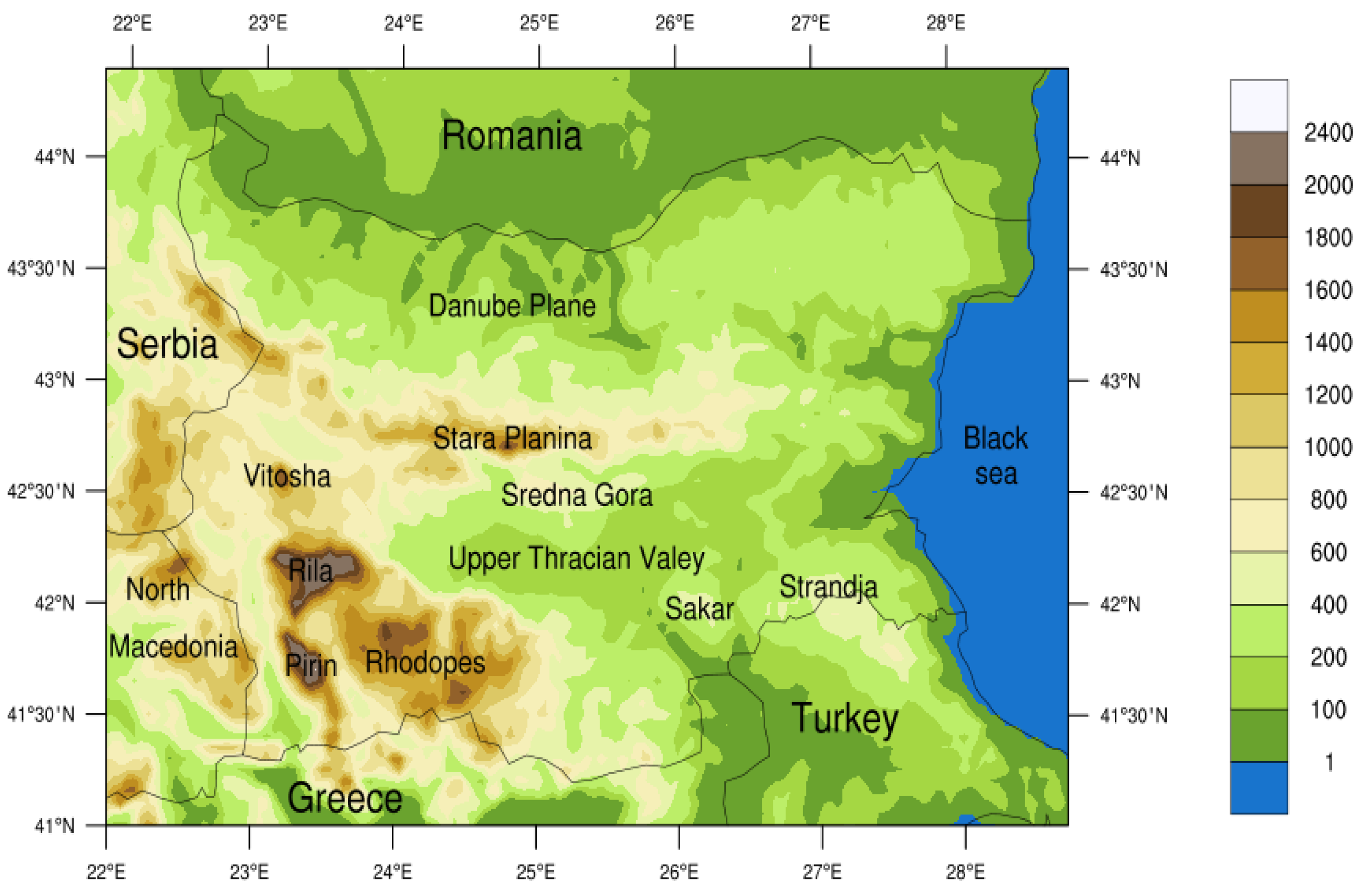
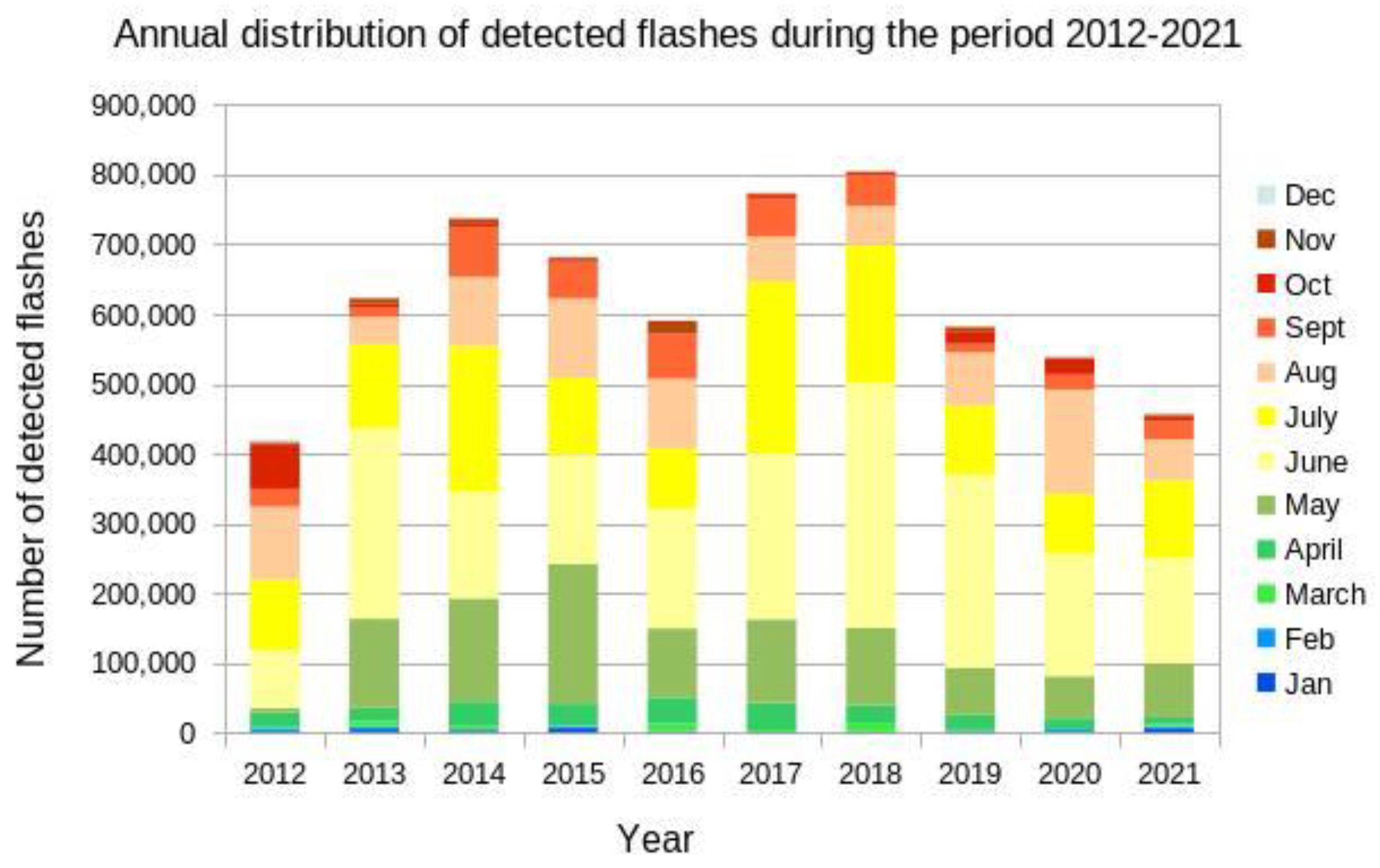

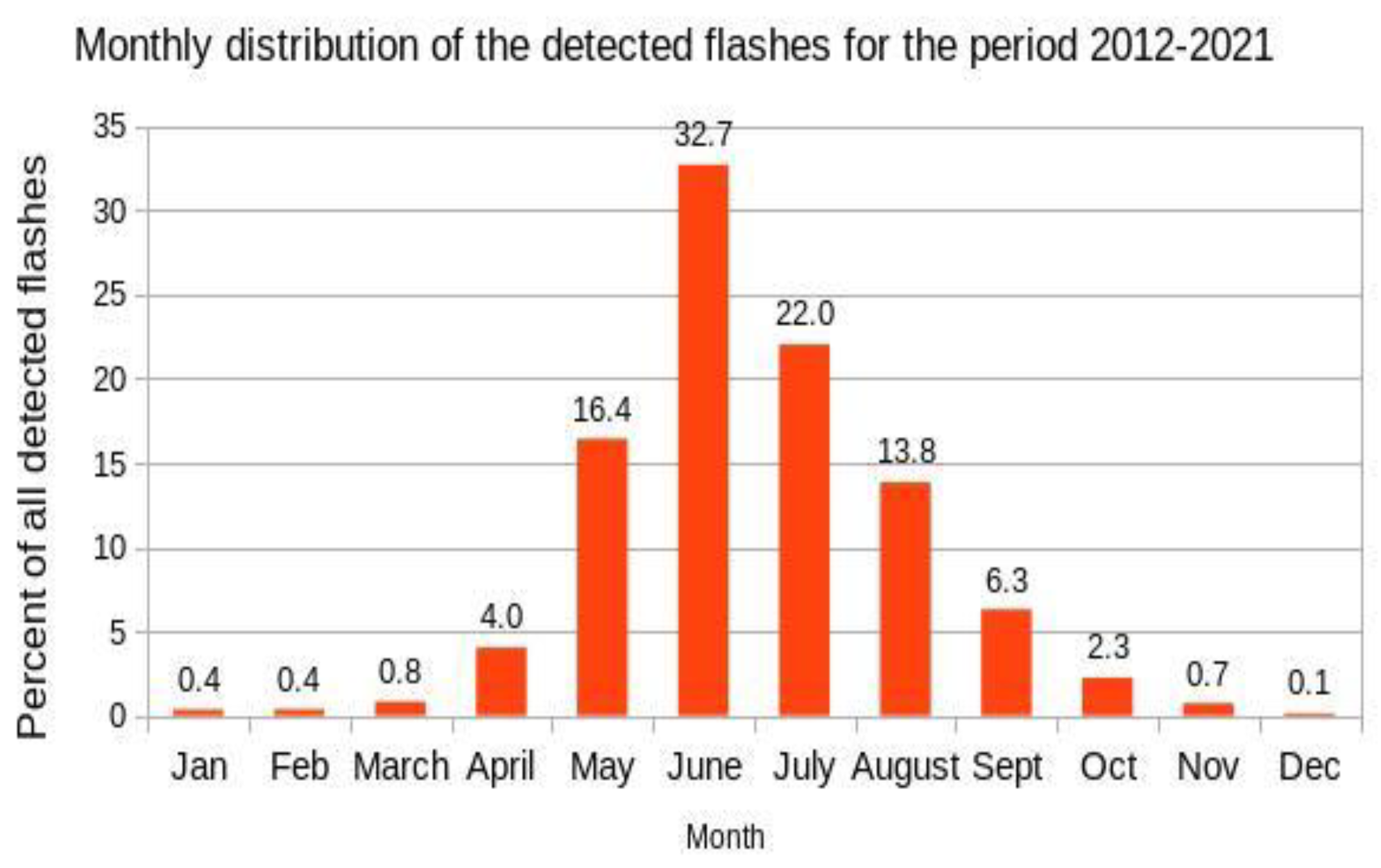
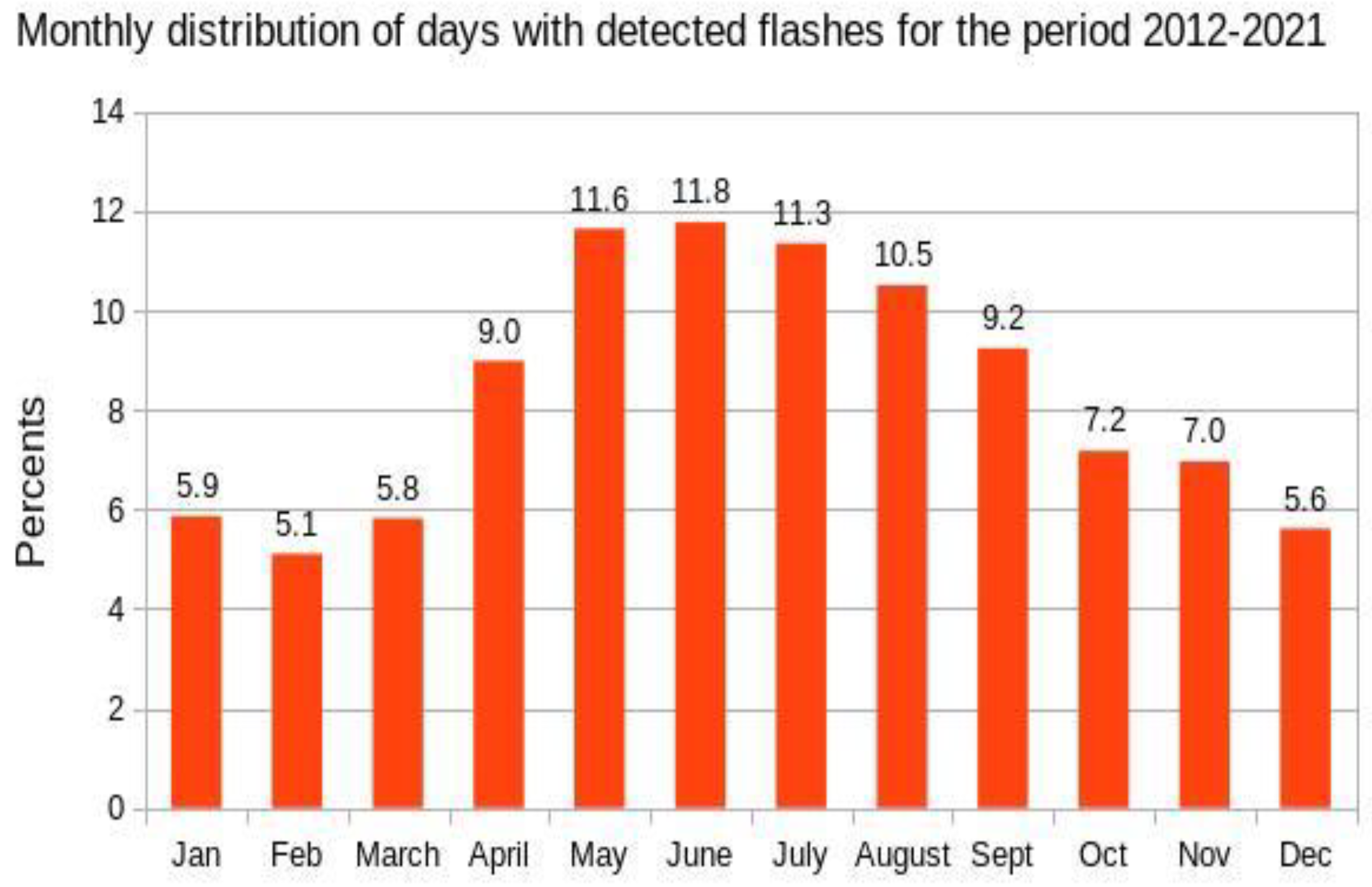
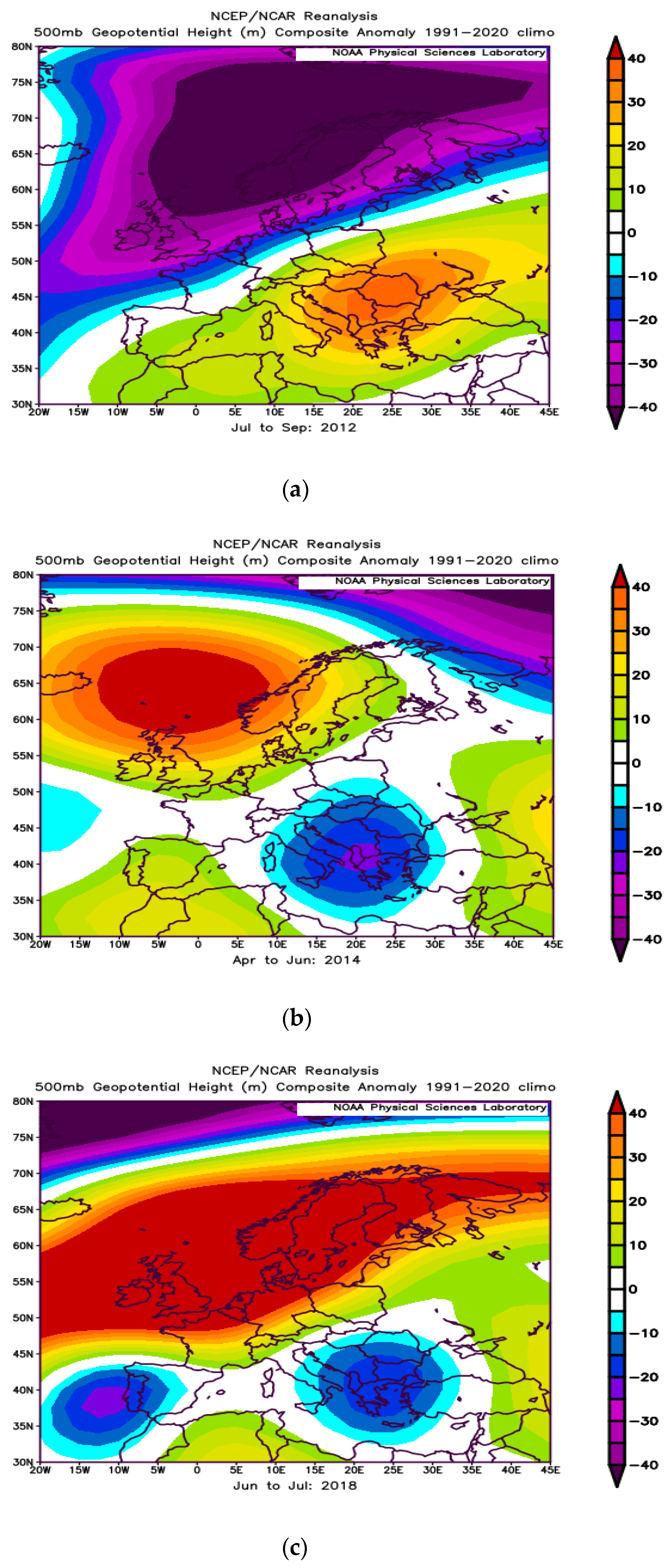
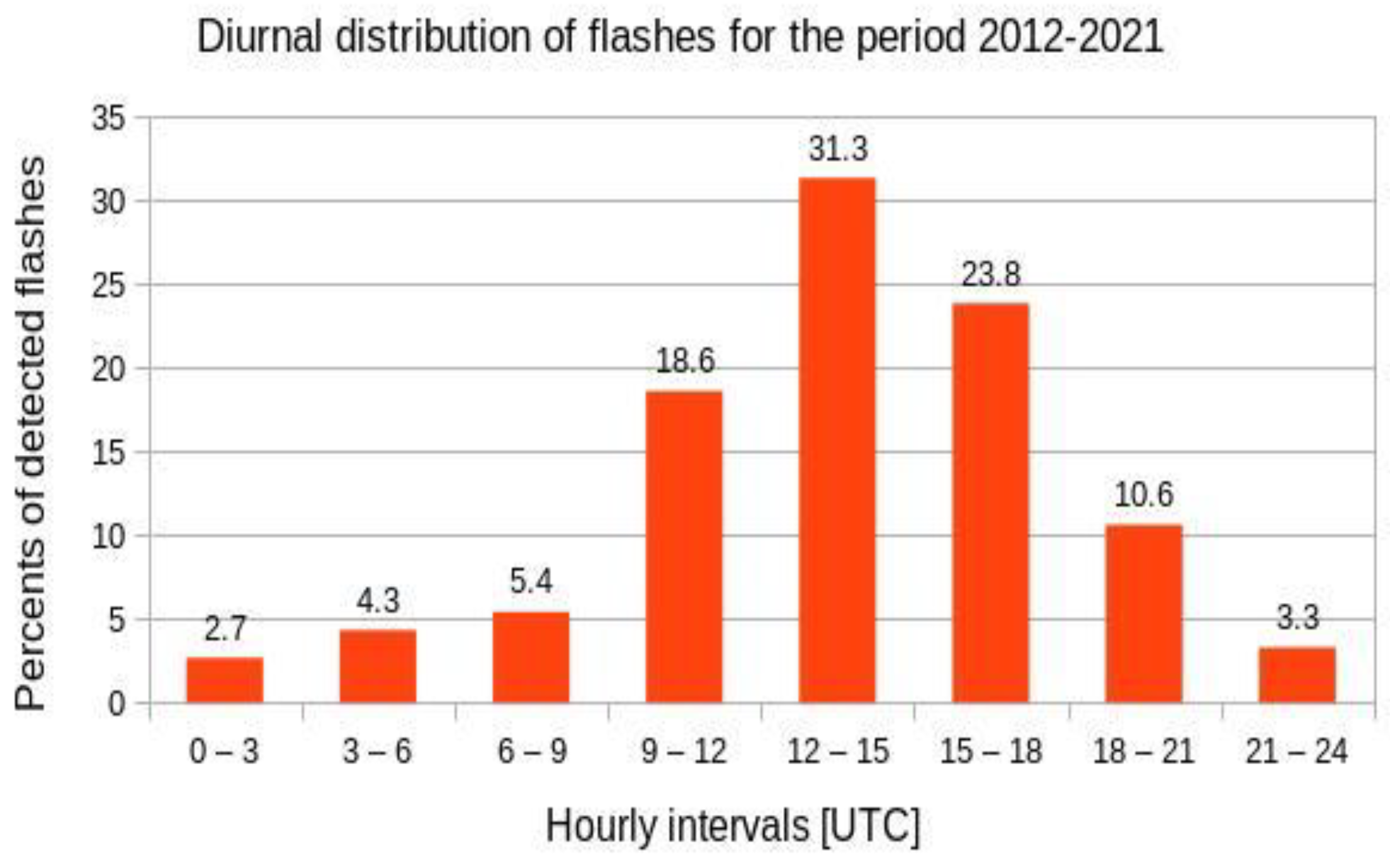


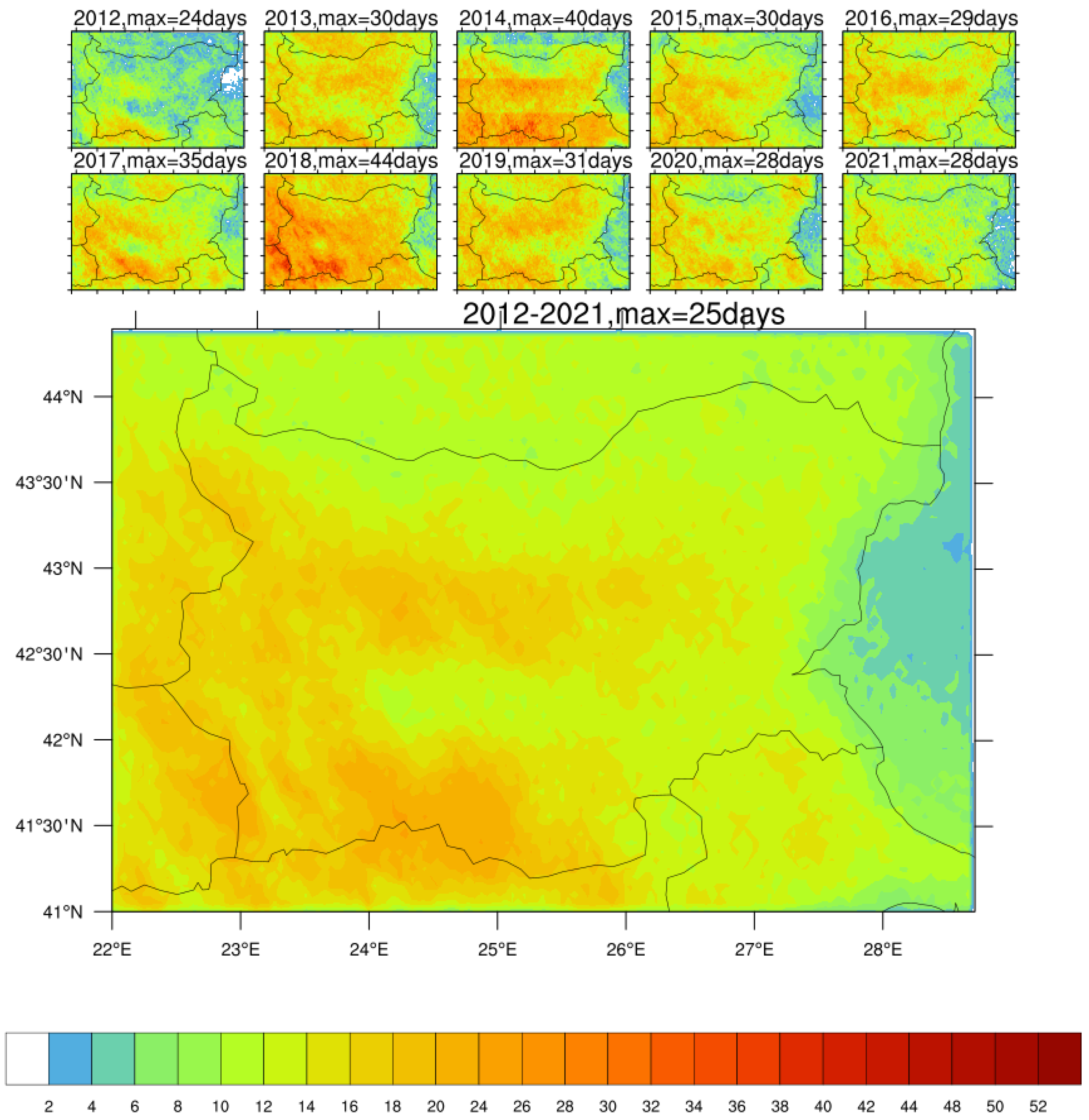
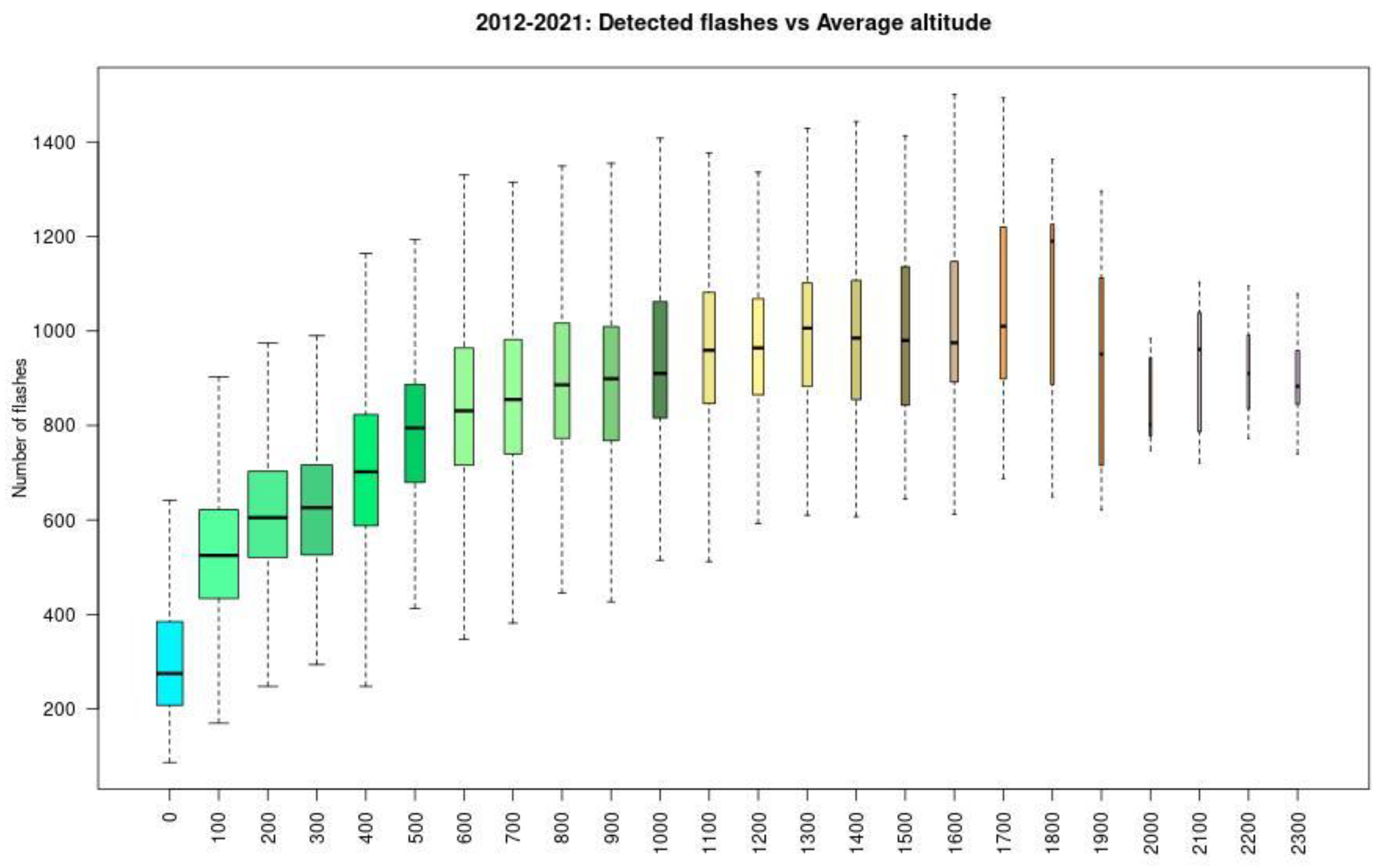

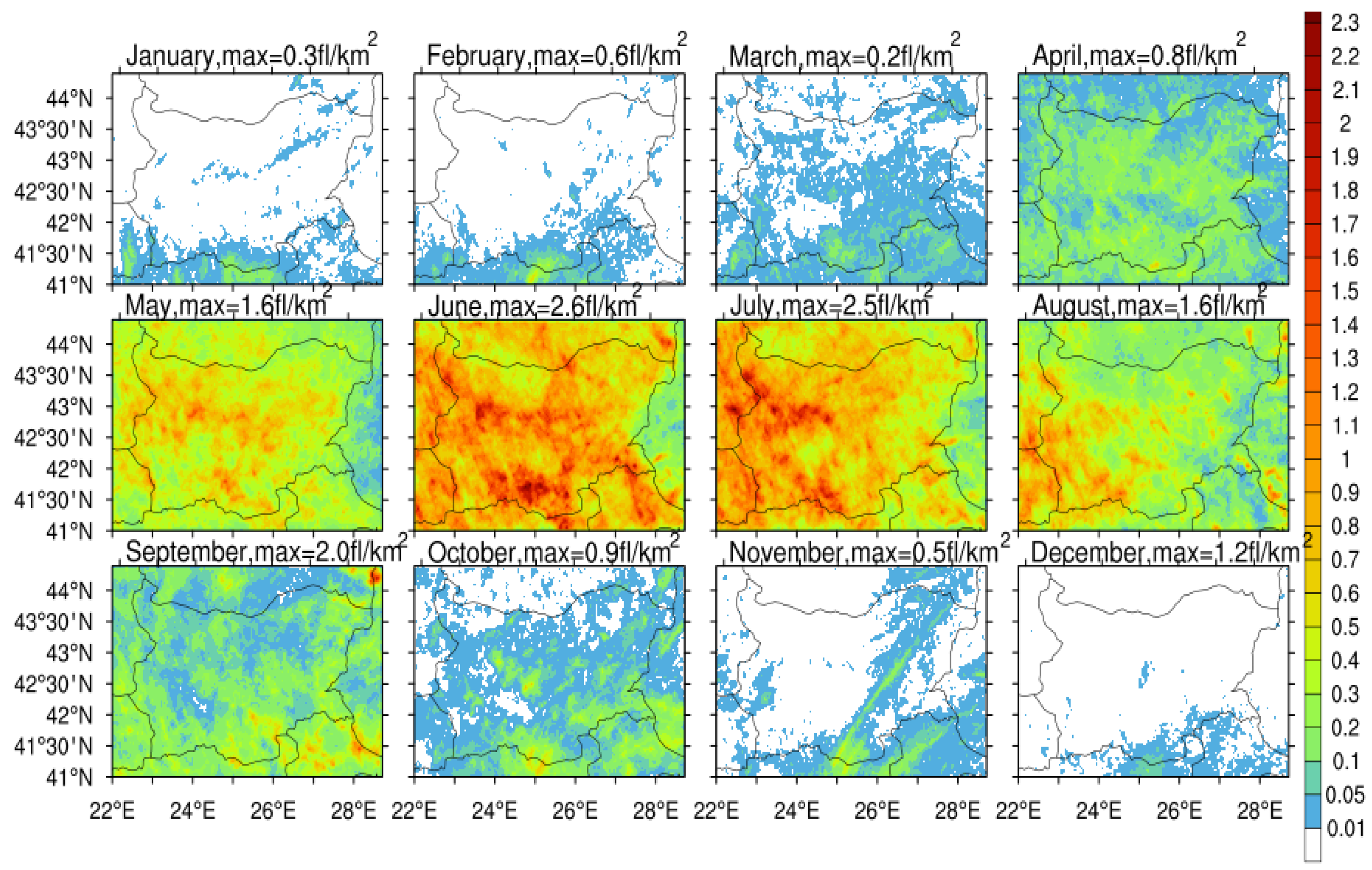
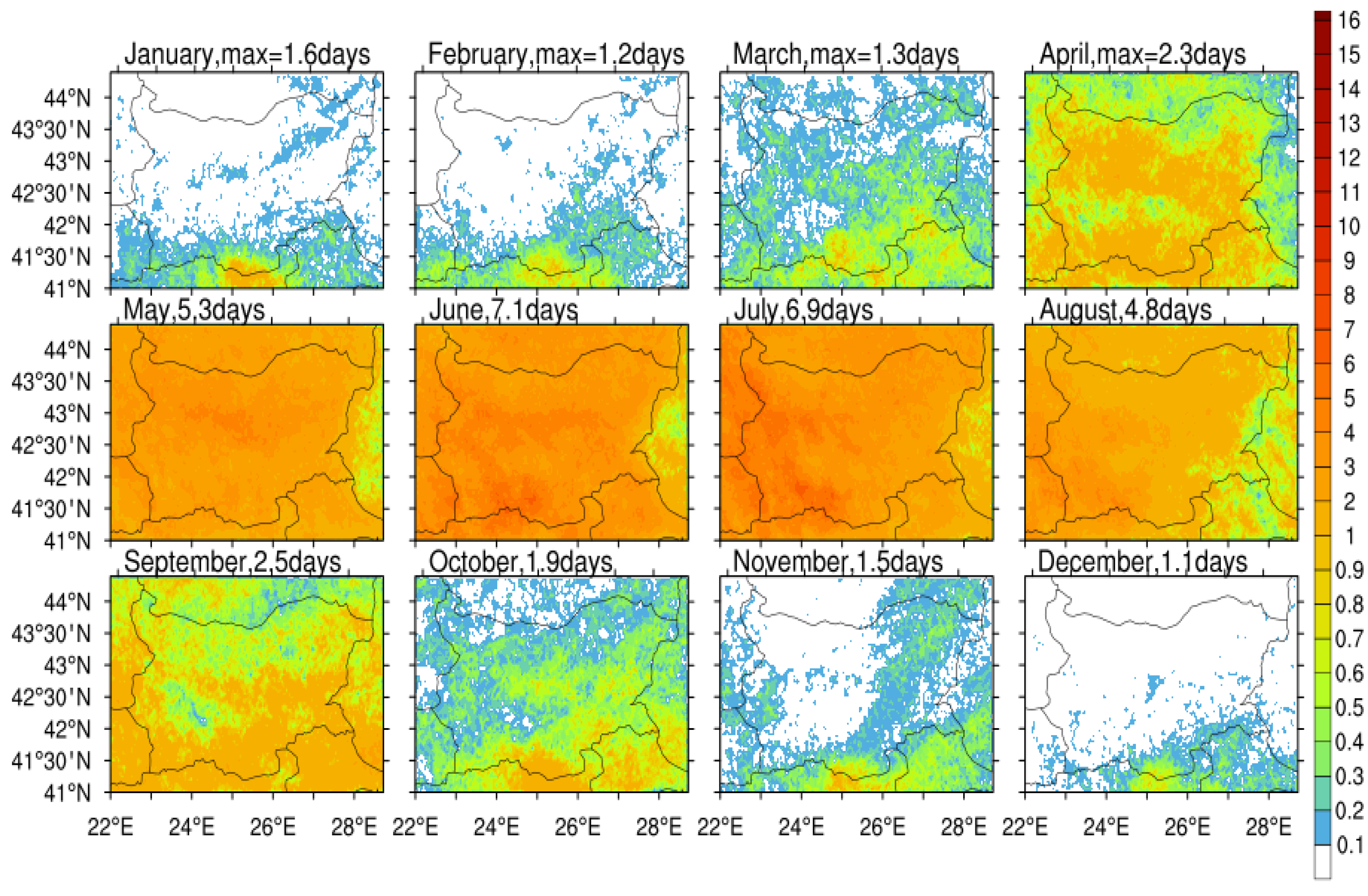
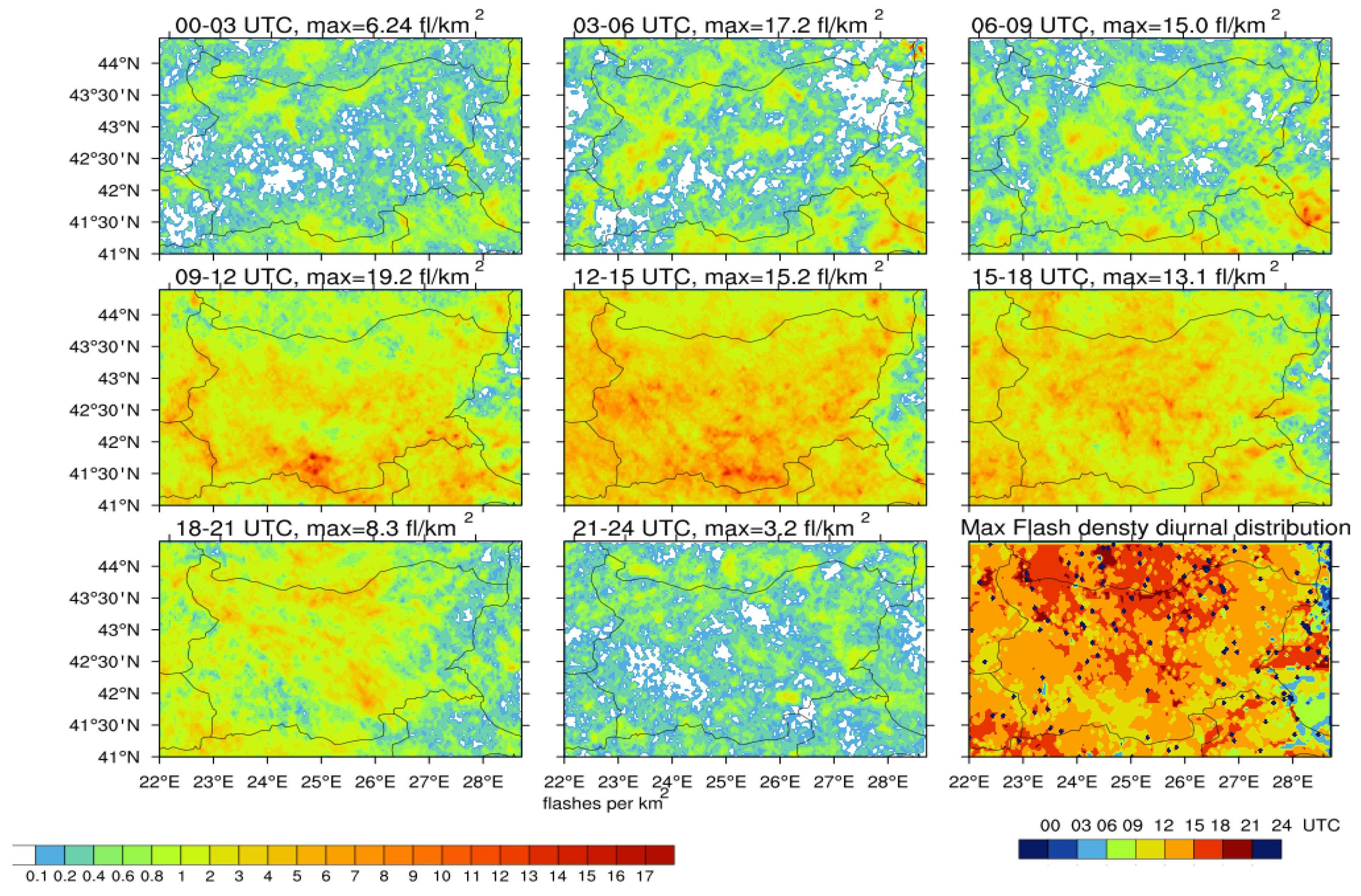
Publisher’s Note: MDPI stays neutral with regard to jurisdictional claims in published maps and institutional affiliations. |
© 2022 by the authors. Licensee MDPI, Basel, Switzerland. This article is an open access article distributed under the terms and conditions of the Creative Commons Attribution (CC BY) license (https://creativecommons.org/licenses/by/4.0/).
Share and Cite
Tsenova, B.D.; Gospodinov, I. Temporal and Spatial Distribution of Lightning Activity over Bulgaria during the Period 2012–2021 Based on ATDnet Lightning Data. Climate 2022, 10, 184. https://doi.org/10.3390/cli10110184
Tsenova BD, Gospodinov I. Temporal and Spatial Distribution of Lightning Activity over Bulgaria during the Period 2012–2021 Based on ATDnet Lightning Data. Climate. 2022; 10(11):184. https://doi.org/10.3390/cli10110184
Chicago/Turabian StyleTsenova, Boryana Dimitrova, and Ilian Gospodinov. 2022. "Temporal and Spatial Distribution of Lightning Activity over Bulgaria during the Period 2012–2021 Based on ATDnet Lightning Data" Climate 10, no. 11: 184. https://doi.org/10.3390/cli10110184
APA StyleTsenova, B. D., & Gospodinov, I. (2022). Temporal and Spatial Distribution of Lightning Activity over Bulgaria during the Period 2012–2021 Based on ATDnet Lightning Data. Climate, 10(11), 184. https://doi.org/10.3390/cli10110184






